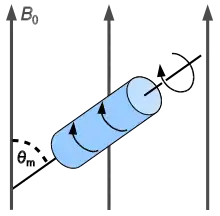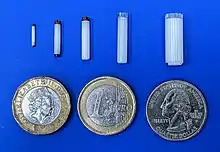
In solid-state NMR spectroscopy, magic-angle spinning (MAS) is a technique routinely used to produce better resolution NMR spectra. MAS NMR consists in spinning the sample (usually at a frequency of 1 to 130 kHz) at the magic angle θm (ca. 54.74°, where cos2θm=1/3) with respect to the direction of the magnetic field.
Three main interactions responsible in solid state NMR (dipolar, chemical shift anisotropy, quadrupolar) often lead to very broad and featureless NMR lines. However, these three interactions in solids are orientation-dependent and can be averaged to some extent by MAS:
- The nuclear dipolar interaction has a dependence, where is the angle between the internuclear axis and the main magnetic field. As a result, the dipolar interaction vanish at the magic angle θm and the interaction contributing to the line broadening is removed. Even though all internuclear vectors cannot be all set to the magic angle, rotating the sample around this axis produces the same effect, provided the frequency is comparable to that of the interaction. In addition, a set of spinning sidebands appear on the spectra, which are sharp lines separated from the isotropic resonance frequency by a multiple of the spinning rate.
- The chemical shift anisotropy (CSA) represents the orientation-dependence of the chemical shift. Powder patterns generated by the CSA interaction can be averaged by MAS, resulting to one single resonance centred at the isotropic chemical shift (centre of mass of the powder pattern).
- The quadrupolar interaction is only partially averaged by MAS leaving a residual secondary quadrupolar interaction.
In solution-state NMR, most of these interactions are averaged out because of the rapid time-averaged molecular motion that occurs due to the thermal energy (molecular tumbling).

The spinning of the sample is achieved via an impulse air turbine mechanism, where the sample tube is lifted with a frictionless compressed gas bearing and spun with a gas drive. Sample tubes are hollow cylinders coming in a variety of outer diameters ranging from 0.70 to 7 mm, mounted with a turbine cap. The rotors are typically made from zirconium oxide, although other ceramic materials (silicon nitride) or polymers (poly(methyl methacrylate) (PMMA), polyoxymethylene (POM)) can be found. Removable caps close the ends of the sample tube. They are made from a range of materials typically Kel-F, Vespel, or zirconia and boron nitride for an extended temperature range.
Magic-angle spinning was first described in 1958 by Edward Raymond Andrew, A. Bradbury, and R. G. Eades[1] and independently in 1959 by I. J. Lowe.[2] The name "magic-angle spinning" was coined in 1960 by Cornelis J. Gorter at the AMPERE congress in Pisa.[3]
Variations
High Resolution Magic-Angle Spinning (HR-MAS)
HRMAS is usually applied to solutions and gels where dipole-dipole interactions are insufficiently averaged by the intermediate molecular motion. HRMAS can dramatically average out residual dipolar interactions and result in spectra with linewidths similar to solution-state NMR. HRMAS links the gap between solution-state and solid-state NMR, and enable the use of solution-state experiments[4]
HRMAS and its medical research application was first described in a 1997 study of human brain tissues from a neurodegenerative disorder.[5]
Solution Magic Angle Spinning
Use of Magic Angle Spinning has been extended from solid-state to liquid (solution) NMR.[6]
Magic angle turning
The magic-angle-turning (MAT) technique introduced by Gan employs slow (approximately 30 Hz) rotation of a powdered sample at the magic angle, in concert with pulses synchronized to 1/3 of the rotor period, to obtain isotropic-shift information in one dimension of a 2D spectrum.[7]
Magic angle spinning spheres
Rather than using cylindrical rotors, spinning spheres can be spun stably at the magic angle, which can be used to increase the filling factor of the coils, hence improve the sensitivity.[8] Magic angle spinning spheres allow stable MAS with faster spinning rates.[9]
Applications
There are significant advantages to using MAS NMR in structural biology. Magic angle spinning can be used to characterize large insoluble systems, including biological assemblies and intact viruses, that cannot be studied with other methods.[10]
References
- ↑ E. R. Andrew; A. Bradbury; R. G. Eades (1958). "Nuclear magnetic resonance spectra from a crystal rotated at high speed". Nature. 182 (4650): 1659. Bibcode:1958Natur.182.1659A. doi:10.1038/1821659a0.
- ↑ I. J. Lowe (1959). "Free Induction Decays of Rotating Solids". Phys. Rev. Lett. 2 (7): 285–287. Bibcode:1959PhRvL...2..285L. doi:10.1103/PhysRevLett.2.285.
- ↑ Jacek W. Hennel; Jacek Klinowski (2005). "Magic Angle Spinning: A Historical Perspective". In Jacek Klinowski (ed.). New techniques in solid-state NMR. Vol. 246. Springer. pp. 1–14. doi:10.1007/b98646. ISBN 978-3-540-22168-5. PMID 22160286.
{{cite book}}:|journal=ignored (help) (New techniques in solid-state NMR, p. 1, at Google Books) - ↑ Händel, Heidi; Gesele, Elke; Gottschall, Klaus; Albert, Klaus (2003). "Application of HRMAS 1H NMR Spectroscopy To Investigate Interactions between Ligands and Synthetic Receptors". Angewandte Chemie International Edition. 42 (4): 438–442. doi:10.1002/anie.200390133. PMID 12569511.
- ↑ Cheng, Leo; et., al. (1997). "Quantitative neuropathology by high resolution magic angle spinning proton magnetic resonance spectroscopy". Proc Natl Acad Sci U S A. 94 (12): 6408–13. Bibcode:1997PNAS...94.6408C. doi:10.1073/pnas.94.12.6408. PMC 21063. PMID 9177231.
- ↑ Polenova, Tatyana; Gupta, Rupal; Goldbourt, Amir (20 Mar 2016). "Magic Angle Spinning NMR Spectroscopy: A Versatile Technique for Structural and Dynamic Analysis of Solid-Phase Systems". Analytical Chemistry. 87 (11): 5458–5469. doi:10.1021/ac504288u. PMC 4890703. PMID 25794311.
- ↑ Hu, J.Z.; Wang, W.; Liu, F.; Solum, M.S.; Alderman, D.W.; Pugmire, R.J.; Grant, D.M. (1995). "Magic-Angle-Turning Experiments for Measuring Chemical-Shift-Tensor Principal Values in Powdered Solids". Journal of Magnetic Resonance, Series A. 113 (2): 210–222. Bibcode:1995JMagR.113..210H. doi:10.1006/jmra.1995.1082.
- ↑ Chen, Pinhui; Albert, Brice J.; Gao, Chukun; Alaniva, Nicholas; Price, Lauren E.; Scott, Faith J.; Saliba, Edward P.; Sesti, Erika L.; Judge, Patrick T.; Fisher, Edward W.; Barnes, Alexander B. (2018). "Magic angle spinning spheres". Science Advances. 4 (9): eaau1540. Bibcode:2018SciA....4.1540C. doi:10.1126/sciadv.aau1540. ISSN 2375-2548. PMC 6155130. PMID 30255153.
- ↑ Osborn Popp, Thomas M.; Däpp, Alexander; Gao, Chukun; Chen, Pin-Hui; Price, Lauren E.; Alaniva, Nicholas H.; Barnes, Alexander B. (2020-06-18). "Highly stable magic angle spinning spherical rotors". Magnetic Resonance. 1 (1): 97–103. doi:10.5194/mr-1-97-2020. hdl:20.500.11850/465781. ISSN 2699-0016. S2CID 221741694.
- ↑ Porat-Dahlerbruch, Gal; Goldbourt, Amir; Polenova, Tatyana (29 September 2021). "Virus Structures and Dynamics by Magic-Angle Spinning NMR". Annual Review of Virology. 8 (1): 219–237. doi:10.1146/annurev-virology-011921-064653. ISSN 2327-056X. PMC 8973440. PMID 34586870.